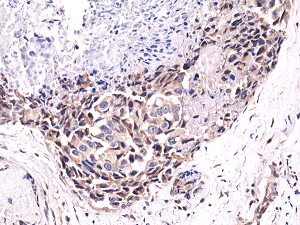AKT antibody [N3C2], Internal
GTX121937
ApplicationsImmunoFluorescence, ImmunoPrecipitation, Western Blot, ImmunoCytoChemistry, ImmunoHistoChemistry, ImmunoHistoChemistry Frozen, ImmunoHistoChemistry Paraffin
Product group Antibodies
TargetAKT1
Overview
- SupplierGeneTex
- Product NameAKT antibody [N3C2], Internal
- Delivery Days Customer9
- Application Supplier NoteWB: 1:500-1:3000. ICC/IF: 1:100-1:1000. IP: 1:100-1:500. *Optimal dilutions/concentrations should be determined by the researcher.Not tested in other applications.
- ApplicationsImmunoFluorescence, ImmunoPrecipitation, Western Blot, ImmunoCytoChemistry, ImmunoHistoChemistry, ImmunoHistoChemistry Frozen, ImmunoHistoChemistry Paraffin
- CertificationResearch Use Only
- ClonalityPolyclonal
- Concentration0.67 mg/ml
- ConjugateUnconjugated
- Gene ID207
- Target nameAKT1
- Target descriptionAKT serine/threonine kinase 1
- Target synonymsAKT; AKT1m; PKB; PKB alpha; PKB-ALPHA; PRKBA; protein kinase B alpha; proto-oncogene c-Akt; RAC; rac protein kinase alpha; RAC-ALPHA; RAC-alpha serine/threonine-protein kinase; RAC-PK-alpha; serine-threonine protein kinase; v-akt murine thymoma viral oncogene homolog 1; v-akt murine thymoma viral oncogene-like protein 1
- HostRabbit
- IsotypeIgG
- Scientific DescriptionThe serine-threonine protein kinase encoded by the AKT1 gene is catalytically inactive in serum-starved primary and immortalized fibroblasts. AKT1 and the related AKT2 are activated by platelet-derived growth factor. The activation is rapid and specific, and it is abrogated by mutations in the pleckstrin homology domain of AKT1. It was shown that the activation occurs through phosphatidylinositol 3-kinase. In the developing nervous system AKT is a critical mediator of growth factor-induced neuronal survival. Survival factors can suppress apoptosis in a transcription-independent manner by activating the serine/threonine kinase AKT1, which then phosphorylates and inactivates components of the apoptotic machinery. Mutations in this gene have been associated with the Proteus syndrome. Multiple alternatively spliced transcript variants have been found for this gene. [provided by RefSeq, Jul 2011]
- Storage Instruction-20°C or -80°C,2°C to 8°C
- UNSPSC12352203
References
- StAR-related lipid transfer domain protein 3 (STARD3) regulates HER2 and promotes HER2-positive breast cancer progression through interaction with HSP90 and SRC signaling.Read more
- Vasculoprotective Potential of Baicalein in Angiotensin II-Infused Abdominal Aortic Aneurysms through Inhibiting Inflammation and Oxidative Stress.Read more
- Enhancing the inhibition of cell proliferation and induction of apoptosis in H22 hepatoma cells through biotransformation of notoginsenoside R1 by Lactiplantibacillus plantarum S165 into 20(S/R)-notoginsenoside R2.Read more
- Eukaryotic translation initiation factor 2alpha kinase 2 in pancreatic cancer: An approach towards managing clinical prognosis and molecular immunological characterization.Read more
- Lactiplantibacillus plantarum ELF051 Alleviates Antibiotic-Associated Diarrhea by Regulating Intestinal Inflammation and Gut Microbiota.Read more
- BFNB Enhances Hair Growth in C57BL/6 Mice through the Induction of EGF and FGF7 Factors and the PI3K-AKT-beta-Catenin Pathway.Read more
- alpha-Viniferin-Induced Apoptosis through Downregulation of SIRT1 in Non-Small Cell Lung Cancer Cells.Read more
- Senolytic Flavonoids Enhance Type-I and Type-II Cell Death in Human Radioresistant Colon Cancer Cells through AMPK/MAPK Pathway.Read more
- The Attenuation of Insulin/IGF-1 Signaling Pathway Plays a Crucial Role in the Myo-Inositol-Alleviated Aging in Caenorhabditis elegans.Read more
- P-15 promotes chondrocyte proliferation in osteoarthritis by regulating SFPQ to target the Akt-RUNX2 axis.Read more

![WB analysis of NIH3T3 (1), HeLa (2),COS7 (3) and Jurkat (4) cell lysate using GTX82762 AKT1 antibody [3A3].](https://www.genetex.com/upload/website/prouct_img/normal/GTX82762/GTX82762_20170912_WB_w_23061322_461.webp)


![IP analysis of MCF-7 cells using GTX10438 AKT1 antibody [PKB-175]. Lane 1 : IP from MCF-7 cells using10 microL antibody Lane 2 : IP from MCF-7 cells using10 microL nonrelevant antibody Lane 3 : MCF-7 whole cell lysate](https://www.genetex.com/upload/website/prouct_img/normal/GTX10438/GTX10438_20170605_IP_w_23060120_654.webp)
